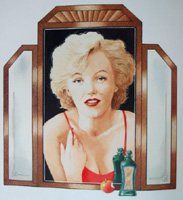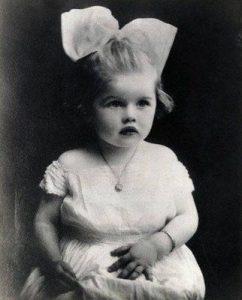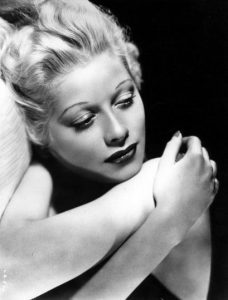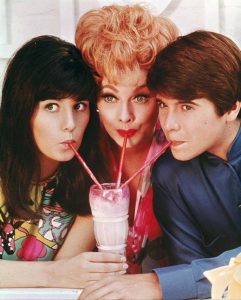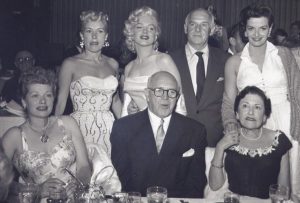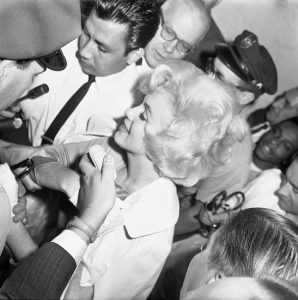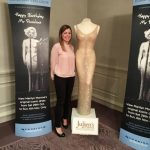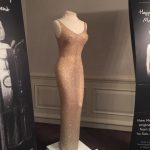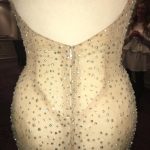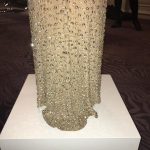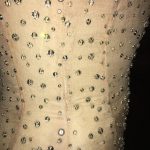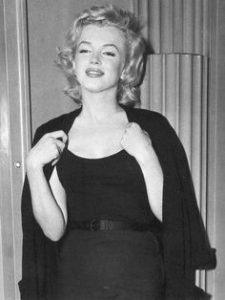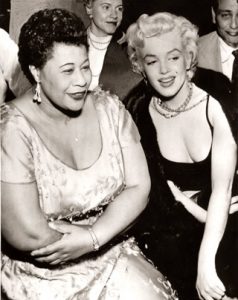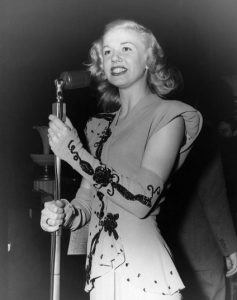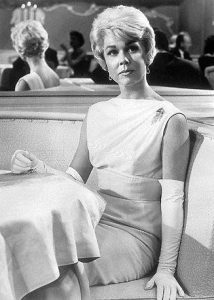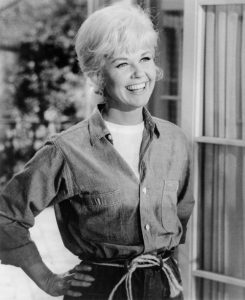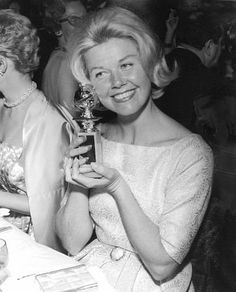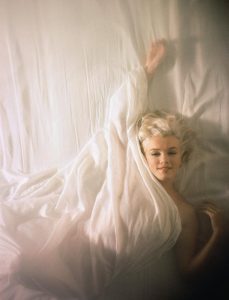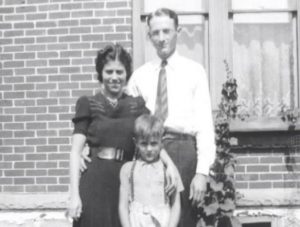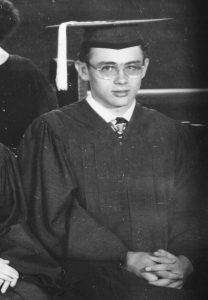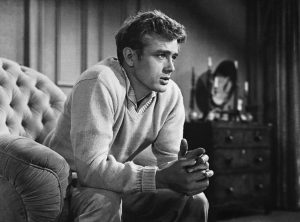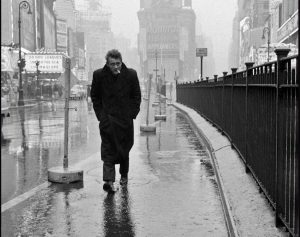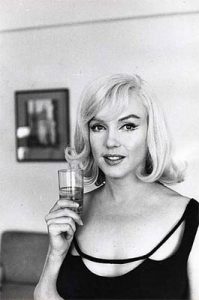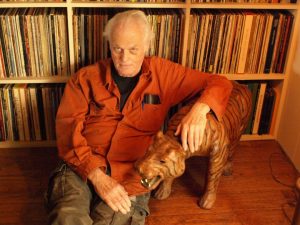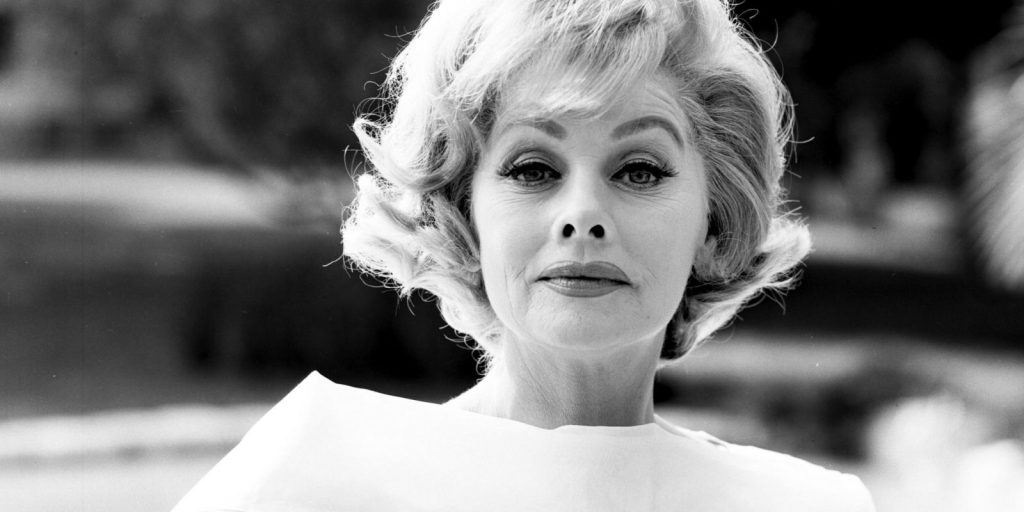
Before the world’s most iconic blonde came the world’s most beloved redhead. Lucille Désirée Ball was born on August 6th, 1911 to mother Désirée “DeDe” (Hunt) Ball and father Henry Ball. When Lucille was three years old, the family moved to Detroit for Henry’s work. “DeDe tried dressing me in ribbons and bows, but I rebelled, never being the prissy doll type. My father roughhoused with me as he might with a boy, tossing me to the ceiling and catching me a few feet from the floor, and giving me piggybacks. I screamed with delight while DeDe worried about the tomboy she was raising.”
Sadly, Lucille’s time with her father was cut short in 1915 when he died of typhoid fever at twenty-eight. DeDe was only twenty-two, and five months pregnant with her second child, Freddy, who was born shortly after Lucille and Dede returned to DeDe’s parents’ Jamestown apartment.
After DeDe remarried to Ed Peterson in 1918, the family was back under one roof again by 1920 in Celoron, New York. Lucille, Freddy, and their cousin Cleo were the best of friends, and often put on stage plays at home to entertain the adults. Lucille, the oldest, spent much of her time taking care of the children, making beds, and cooking dinners while her mother worked full-time selling hats at a dress shop to make ends meet.
Lucille developed a passion for performing on stage. She took part in many school productions throughout her high school career and cherished the joy and laughs she could provide for an audience. However, she was a feisty teenager and often got into fights at school. She would run away, taking her little fox terrier, with her. DeDe, becoming increasingly worried for her daughter’s future, but always supportive of her acting aspirations, decided to help her attend dramatic classes.
Lucille began her training in New York at the John Murray–Robert Milton theater school where Bette Davis was also a student. She worked incredibly hard but couldn’t dance or sing, and was dismissed as talentless by her teachers and fellow pupils.
After leaving the academy, Lucille wandered around New York, managing to get cast in bit parts in a few musicals, but rarely stayed long enough to be part of the finished product. She earned money by modeling until a chance meeting became her ticket to Tinseltown. Theatrical agent Sylvia Halo recognized Lucille on the street from a billboard she had posed for to advertise Chesterfield cigarettes. MGM had chosen twelve poster girls to appear in a film called Roman Scandals, and one of the girls had dropped out last minute. Lucille was hired on the spot by Sam Goldwyn’s New York agent, and was off to Hollywood three days later.
Following Roman Scandals, Lucille landed a contract with RKO. This led to an essential build up in her career, training under the renowned Lela Rogers, mother and manager of Ginger Rogers. The late 1930’s were a happy time for Lucille; she made friends and reunited with her family who moved into her bungalow in Hollywood. She was given small parts in Astaire-Rogers productions including Top Hat and Follow The Fleet.
At the end of 1939, Lucille met her “Cuban skyrocket,” Desi Arnaz. They met for the first time in New York where Arnaz was starring in a Broadway show called Too Many Girls. They instantly fell head over heels in love, and it wasn’t long before they slipped away to Connecticut to elope in November of 1940. The young couple had countless verbal fights, but were passionately devoted to each other. Lucille called it their way of love-making. Years later, Lucille delivered two healthy babies: Lucie Arnaz and Desi Arnaz Jr.
Desilu Productions was formed in 1950. After collaborating for a vaudeville act, CBS agreed to finance a television show starring the husband-wife duo. I Love Lucy ran from 1951-1957 before switching to a longer time slot for The Lucy-Desi Comedy Hour, which ran from 1957 until their divorce in 1960. During this time, Desilu made a huge financial decision: the company bought out RKO Pictures for over $6 million. By 1960, their marriage had fallen apart but still they finished working on The Lucy-Desi Comedy Hour.
Shortly after her divorce, Lucille started a romance with stand-up comedian Gary Morton after being introduced to each other by mutual friends in New York. Morton loved Lucille, was great with the kids, and after a busy career, was ready to settle down with a family. In November of 1961, the couple married.
By 1962, Lucille and Desi kept in touch more often, communicated easier about the children, and got along nicely. They would even collaborate on The Lucy Show (1962-1968) in which they brought back beloved I Love Lucy star Vivian Vance. Soon after, Lucille made the decision to buy Desi’s controlling interest in Desilu Productions, making her the first female in Hollywood to become president of a major television studio.
Lucille went on to film Here’s Lucy (1968-1974) and made a comeback in 1986 with Life With Lucy. She made several films and musicals in between. She received a plethora of awards throughout her career and donated an incredible amount of time and money to various charities and benefits. She passed away suddenly at her home in Beverly Hills at the age of seventy-seven from an acute aortic aneurysm on April 26, 1989.
Career Similarities
Both Marilyn and Lucille pursued modeling before being signed to major studios. Their common flaw was being told by their superiors that they were “un-photogenic.” This, although discouraging, didn’t stop the girls from working even harder to succeed. Lucille modeled fashion while Marilyn’s photos were cheesecake style. Marilyn was known among photographers and the head of her modeling agency that fashion modeling just wasn’t for her. Lucille was skinny and avoided bathing suit shots.
Both went through the usual up and coming procedure of an actress by appearing in a lot of bit parts in films, Lucille being casted in more A-films and Marilyn in B-films. They have many studios in common such as MGM, RKO, United Artists, Columbia Pictures, and 20th Century Fox.
Each woman published a posthumous autobiography. As her career was reaching its peak, Marilyn worked with Ben Hecht on a story of her life in the form of magazine articles, but they were not published in book form, titled “My Story,” until 1974, when it was compiled by Hecht using his original interviews and notes. In the early 60’s, Lucille began working with Betty Hoffman to create an “as told to” autobiography. She wrote a manuscript and recorded herself telling the story of her life up until 1964, when the project was shelved. The discovery of this work didn’t come until Lucille’s attorney was sifting through file boxes after Lucille’s death. The contents became “Love, Lucy” published in 1996.
Personal Connections
Unfortunately, a tragic similarity can be found in these two women. Marilyn suffered an ectopic pregnancy in 1957 and a miscarriage in 1958. She desperately wanted to have children, but was never able to. Lucille had children later in life, but before then, she also endured the pain of two miscarriages, which occurred in 1942 and 1950.
Name and other Connections
Sydney Guliaroff – Began styling Marilyn’s hair at MGM for The Asphalt Jungle during her short time at MGM. Styled Lucille when she was signed again to MGM in 1942
Ginger Rogers – Became quick friends with Lucille at RKO in the late 1930’s. Marilyn worked with Ginger in We’re Not Married (1952) and Monkey Business (1952).
Harry Cohn – Terminated Marilyn’s six month contract with Columbia Pictures in 1949, and is said to have made some degrading remarks about her. In 1950, Lucille was also having trouble with Cohn; he wouldn’t let her pursue an important role at Paramount. Lucille outsmarted him in the end. Her contract required one more film of her to which she would earn $85,000. She agreed to appear in a “Class E” film that only took five days for her to complete. She pocketed half the film’s budget.
Keith Andes – Starred alongside Marilyn in Clash By Night (1952). Starred alongside Lucille in the musical Wildcat (1960).
HUAC – Arthur Miller, Marilyn’s husband at the time, was famously called to appear before the HUAC in 1956, although there was no evidence to substantiate him belonging to the Communist party. In 1936, Lucille registered as a Communist at the insistence of her grandfather so that her and her brother could vote for his friend who was running for city council at the time. Lucille never actually voted Communist or contributed to Communism in any way, and after a long struggle, she was cleared.
Marilyn and Lucille even met on at least one occasion at a party for Walter Winchell at Ciro’s nightclub in Hollywood in 1953.
Both Lucille Ball and Marilyn Monroe have achieved legendary status in their own ways. Lucille will always be treasured as the zany redhead who “made some noise” in Hollywood and throughout the world, just as she set out to do. Marilyn will live on in the hearts of millions as the blonde who challenged the censors and took her career by the horns. Both timeless, classy ladies were two of the most successful women in Hollywood, leaving behind countless films and other media and will be honored forever.
-Ky Monroe for Immortal Marilyn
Hey there Marilyn fans! Another week gone by and as usual, our girl is in the news! Here’s a roundup of what went down in Marilyn-dom this past week!
Reports of the death of surgeon Dr. Ramon Acosta Pastor surfaced early this week, after the doctor passed away a few weeks ago on October 5th. Dr. Pastor performed Marilyn’s 1961 gallbladder removal surgery at Polyclinic Hospital in New York. Pastor can be seen at Marilyn’s side as the press accosted her on her way out of the hospital.
Just in time for Halloween, Cut.com, the website responsible for the popular 100 Years of Beauty videos, has launched a series of How-To videos. According to People, one of the videos includes a tutorial on how to get Marilyn’s makeup look down pat. You’ve got a few days to practice the look before trick-or-treating time!
Scott Fortner announced his forthcoming interview with Anna Strasberg, to be published on his site, The Marilyn Monroe Collection on November 1st. Strasberg, who inherited Marilyn’s estate from husband Lee Strasberg as his second wife, has been a person of much controversy in the Marilyn community over the years. Should be interesting to see what she has to say!
And in the biggest news of the week, the Happy Birthday Mr. President dress has landed in Ireland, where it will be on display. The exhibit runs from Oct. 29 through Nov. 6 at the Museum of Style Icons in Newbridge. After this exhibit it returns stateside, where it will be auctioned off by Julien’s. Online bidding has already hit the million dollar mark and it’s sure to go much higher. IM’s Jackie Cooney got an exclusive pre-exhibit look at the dress up close and personal, and while we’re all jealous, we’re also thankful to her for these fantastic photos!
- I
As Marilyn fans, we always get excited when we see a new picture or learn something new about Marilyn. And for those of us who have made a study of her life, there may be nothing quite as exciting as seeing hard evidence surface that backs something you’ve suspected or believed for years. Thanks to the Julien’s auction that’s already live online, we’ve got some new pieces to the constant puzzle that is Marilyn Monroe. In fact, three fairly well-known stories about Marilyn’s life will have to be re-written thanks to evidence found in letters and scraps of paper.
The Tale: Marilyn was blindsided when Arthur announced to the press his plans to marry her. The story goes that Marilyn was completely shocked when Arthur stated that she was to be his wife, but that seems unlikely. She may not have expected the announcement just then, but there has been some evidence uncovered in the past that indicates marriage plans were already in progress before the announcement. Now there’s further proof that Marilyn and Arthur’s engagement wasn’t a surprise. A letter from Arthur up for auction and addressed to Marilyn prior to the announcement clearly states Arthur’s desire to marry Marilyn on his birthday in October and discusses wedding plans. That date was moved up in order for the two to get married before traveling to England so Marilyn could film The Prince and the Showgirl. Since Arthur clearly didn’t know about that trip when this was written, the letter can be placed prior to the travel plans being made and well in advance of the public announcement. So while it remains possible Marilyn was surprised Miller chose that moment to make the announcement, it’s clearly not true that the two weren’t already planning to get married.
The Tale: Marilyn had an affair with Some Like it Hot Co-Star Tony Curtis during filming. This tale comes directly from Curtis himself, who further went on to claim the baby she was carrying during filming – and lost right after – was his. Few Marilyn fans believe his claims, but this note written by Marilyn in response to Curtis comments at the time that “kissing Marilyn was like kissing Hitler” firmly dispels the notion. It reads: “There is only one way he could comment on my sexuality and I’m afraid he hasn’t had the opportunity.” That’s a mic drop on Curtis’ tales of an affair, not that they were believable to begin with.
The Tale: Marilyn was responsible for Ella Fitzgerald’s booking at the Mocambo, promised to be front and center every night, and followed through on that promise. This well-known story comes directly from Ella herself in a 1972 interview for Ms. magazine. Oh, this is such a lovely tale and so very in keeping with who Marilyn was, that it’s actually painful to see it proven false. But a memo up for auction from Marilyn’s secretary Inez Melson makes it quite clear that Marilyn saw Ella at The Tiffany Club, didn’t in fact play a role in Ella’s booking at the Mocambo, and didn’t attend the shows there as she was going to be in New York at the time. This evidence only backs up research already done by IM’s April VeVea, author of Marilyn: A Day in The Life, who previously dug up enough evidence to prove that it didn’t happen the way it went down in history.
It’s always amazing how in spite of the fact that Marilyn’s life has been analyzed and examined down to the most minute details, there are still new facts coming to light, and how even commonly accepted version of events can find themselves changed or even turned on their heads by a simple slip of paper that changes the story. There’s always more to learn about Marilyn!
-Leslie Kasperowicz for Immortal Marilyn

Life and Career
Doris Mary Ann Kappelhoff was born on April 3rd, 1922 (her birth year would later be incorrectly reported as 1924, a date that still appears in some locations) in Cincinnati. Interested in performing from a young age, Doris’ chances of becoming a dancer were ended when a car accident in 1937 injured her legs. She turned instead to singing, and changed her last name to Day in 1939.
Doris worked her way up in the music industry, performing with some of the biggest names of the 40s’, and in 1945 she made it to the top with the hit song Sentimental Journey. By 1946 she was the highest paid female band vocalist in the world – and the big screen was calling. Her love life, however, was not so successful.
Doris married trombonist Al Jorden in 1941, but they divorced two years later among rumours of physical abuse. The marriage did, however, bring Day her one and only child, son Terry. She married again in 1946, this time to saxophonist George Weidler, but the marriage didn’t last through the end of the decade.
Doris signed a contract with Warner Bros., and when Betty Hutton was forced to withdraw from Romance on the High Seas (1948) due to her pregnancy, Doris Day stepped into her first movie role. Her status as a well-known singer led to many roles in musical comedies throughout the early 1950s putting her on the Hollywood map. In 1955 Doris shifted gears with several dramatic roles, including The Man Who Knew Too Much, an Alfred Hitchcock film opposite James Stewart, but it wasn’t long before she found the niche for which is remains best known to this day – the romantic comedy. It was during her rise on the screen that she married for a third time. Martin Melcher was a music producer and again, a musician, but this time the marriage was not so short lived. Melcher started to play a role in Doris’ career, and she would later discover he had squandered millions of dollars of her money.
Doris earned an Academy Award nomination for her role in Pillow Talk (1959), among other successful romantic comedy roles, but as the sexual revolution of the 60s gained momentum, Day’s virginal girl-next-door image didn’t appeal to audiences as it once had. In 1968 she filmed her last movie, With Six You Get Egg Roll.
The year was one of great change for Doris; her husband passed away at the age of 52. Both Doris and Martin were Christian Scientists, and as a result they sought no treatment for the ailments that ended Martin’s life. After a health scare of her own, and the news that her late husband had left her in a financial disaster, Doris Day returned to the screen – this time the small screen. The Doris Day Show ran from 1968-1973.
With her acting career behind her, Doris Day married for a fourth time in 1976, and not to a musician this time. During her marriage to Barry Comden, a maître d’hotel in Beverly Hills, Day channeled her energy into animal activism. She founded The Doris Day Pet Foundation in 1978, a focus that her husband would blame for the dissolution of the marriage – they divorced in 1981. Doris never remarried, but to this day continues to fight for animal rights through various charities.
In 2011, Doris Day became the oldest artist to reach the UK Top 10 with the release of a new album, My Heart. Featuring a variety of previously unreleased tracks, the album was sold in support of the Doris Day Animal League and included a track dedicated to her son, Terry Melcher, who passed away in 2004 from melanoma.
Doris Day remains one of the last living legends of Marilyn’s days and the Golden Age of Hollywood.
Marilyn Connections
Perhaps one of the best-known connections between Marilyn and Doris Day is Marilyn’s last film, Something’s Got to Give. Day was one of those approached to take over Marilyn’s role when she was fired by Fox, but she declined. Doris eventually agreed to make the film in 1963 after Marilyn’s death, and it was renamed Move Over, Darling. The sets built for Something’s Got to Give, as well as some costumes were reused in the film. Frequent Marilyn co-star Thelma Ritter also appeared in the film. Doris was nominated for a Golden Globe for her role.
Another film both considered was The Sleeping Prince. Day had plans in motion to star in a film adaptation to be made in England. Marilyn, however, bought the rights to the play and filmed it as The Prince and The Showgirl.
Like Marilyn, Doris Day named Ella Fitzgerald as her favourite singer, and listened to her albums to improve her own singing skills.
“The one radio voice I listened to above others belonged to Ella Fitzgerald. There was a quality to her voice that fascinated me, and I’d sing along with her, trying to catch the subtle ways she shaded her voice, the casual yet clean way she sang the words.”
In addition to Thelma Ritter, who appeared in several supporting roles in Doris Day films just as she did in some of Marilyn’s films, Day also shared a few other co-stars with Marilyn. She appeared in It Happened To Jane with Marilyn’s Some Like it Hot co-star, Jack Lemmon. The Tunnel of Love placed her opposite Richard Widmark, who worked with Marilyn on Don’t Bother To Knock, and she made Teacher’s Pet with Clark Gable. She also appeared with Lauren Bacall in 1950’s Young Man With a Horn. The year Marilyn died, Doris made That Touch of Mink with Marilyn’s Monkey Business co-star, Cary Grant. Day also worked with Marilyn’s close friend Frank Sinatra, while fellow Rat-Packer Peter Lawford appeared in several episodes of The Doris Day Show.
Doris attended the Seven Year Itch party at Romanoff’s in 1954, so it’s very likely the two met on that occasion.
Marilyn and Doris were both nominated for the Best Actress in a Musical or Comedy award at the 1960 Golden Globes, and both attended the ceremony, where Marilyn won. Doris took home the Henrietta Award for World Film Favourite, a title Marilyn had won before and would win again in 1962. Again, it seems likely they would have run into each other at the ceremony.
Although on the surface Doris Day and Marilyn Monroe – the girl next door and the sex symbol – were polar opposites, they had some things in common. Both loved animals, both counted some of Hollywood’s famously closeted gay men among their close friends (Doris made multiple films with Rock Hudson and was very close friends with him), and both had little interest in wealth. However, Doris’ clean image and conservative beliefs were not just on the surface, and unlike Marilyn she refused to do any nudity. But in the end, both just wanted their work to make people happy.
“I want to smile and I want to make people laugh. And that’s all I want. I like it. I like being happy. I want to make others happy.”
-Leslie Kasperowicz for Immortal Marilyn
Happy Friday Marilyn fans! It’s time for the weekly roundup of what’s new for lovers of the world’s most famous blonde.
Dust off those credit cards, because the Julien’s auction is off and running. Online bidding on what will likely be the Marilyn auction of the century – and I can’t see this one being topped, even if we are only 16 years into the century – has begun on the Julien’s website. The biggest item up for bids, the Happy Birthday Mr. President dress, already has a bid at $1,000,000. The bidding opened on July 17th, and many other items already have bids as well. It seems likely that many will go over their estimates, as Marilyn items commonly do, although we’re keeping our fingers crossed that some of the less wealthy fans among us can get our hands on a few items. We’ll all be waiting to see if the dress can make history again. Are you bidding? We’d love to hear from fans who actually win something!
Douglas Kirkland, who photographed Marilyn in 1961, has been making the news again as an exhibition of his photos makes the rounds. This week he chatted with Australian Vogue about his night with Marilyn and the camera, as well as the other celebrities he caught with his lens. Check out the interview I did with Douglas for IM a few years ago if you want to read more on this thoughts about Marilyn.
Speaking of Australia, Marilyn made big money for the city of Bendigo. The big exhibition held there earlier this year made even bigger profits than expected. The total income for the region as a result of Marilyn’s draw was announced this week; more than 140,000 people made their way to Bendigo for the show, adding up to a $13.2 million dollar windfall for the city.
That’s it for this week’s Marilyn news…have a great weekend, and don’t forget to get your bids in to Julien’s early!
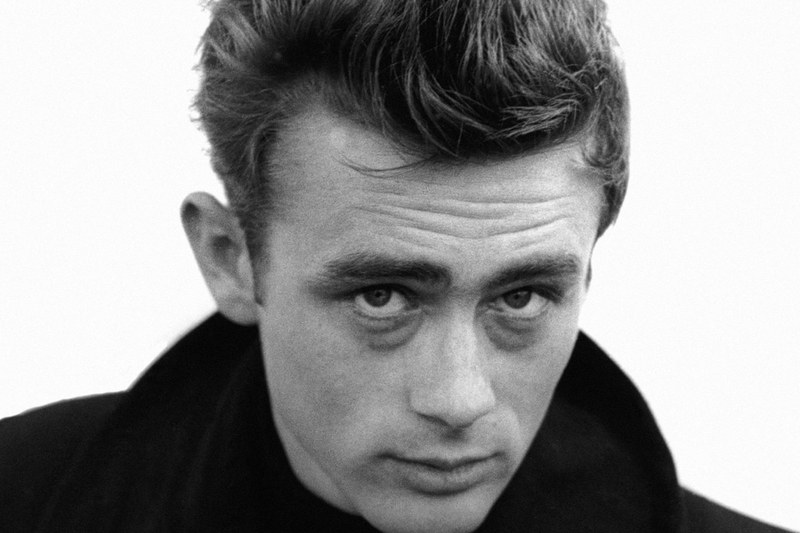
Life and Career
While a lively little toddler called Norma Jeane Baker was cruising through her year at Hawthorne Community Sunday School in Los Angeles, California, the birth of another soon-to-be legend was being celebrated all the way in the Northeast. James Byron Dean was brought into the world on February 8, 1931 in Marion, Indiana, to father Winton and mother Mildred (Wilson) Dean. Jimmy would spend the first years of his life in both Marion with his parents and at his Uncle Marcus and Aunt Ortense Winslow’s farm in Fairmount. In 1935, when Jimmy was around four years old, Winton’s job transferred him to Santa Monica.
Jimmy shared a special bond with his mother. When he was a child, they would often set up miniature stages and perform plays using dolls Jimmy’s world came crashing down when he was nine and his beloved mother died from breast cancer at only twenty-nine. He became angry at the universe for her sudden abandonment, and at times began crying while at school. One of his elementary teachers recalls him silently sobbing at his desk in class and when asked what was wrong, he said in a small voice, “I miss my mom.”
“The only person I could believe was really close to him as a person was his mother. He never really had anybody, because at that point I think Jimmy lost everybody. It was such an irrevocable loss that it could never be filled.” -Barbara Glenn, Jimmy’s girlfriend and confidante
Winton, in-debt with Mildred’s hospital bills, decided it would be best if Jimmy be sent back to Fairmount to live in Marcus and Ortense Winslow’s home for a more stable and providing environment. He spent his days helping out around the farm, doing chores, and playing with Tuck, the family dog, and their small pig. He was a reserved kid and didn’t like to open up about his private life or about his family, but he was very imaginative and loved to perform.
It was during high school that Jimmy got his first taste of performing on stage. Here, he met his first drama coach, Adeline Nall, who cared about and encouraged him to continue theater. Jimmy was, by all accounts, a natural. Throughout his high school years he participated in several plays, sports teams such as basketball and track, and even entered in dramatic competitions.
After graduating with the class of 1949 at Fairmount High School, Jimmy longed to pursue acting further. He moved back in with his father in Los Angeles, who had by then remarried to a woman named Ethel. Him and his father were not very close, and had difficulty communicating. Winton had been physically absent for much of Jimmy’s childhood, and didn’t quite understand his aspirations. After enrolling as a theater major at UCLA, he realized, with the help of others as well, that he had too much talent to be subjected to dead end jobs and minor roles in school productions; he left for New York in 1951 and tried out for the Actors Studio. Of the one hundred and fifty students who auditioned for the prestigious school, Jimmy and his scene partner were the only two who were accepted. Although overjoyed at having succeeded, Jimmy’s time at the Actors Studio is best remembered as a young actor who sat and listened, didn’t participate, and hardly showed up.
After two Broadway shows, director Elia Kazan picked Jimmy up and whisked him away to Hollywood after signing him for his next big film East Of Eden. This was the film that would start getting Jimmy noticed in Hollywood. After this, he would go on to complete two more successful films, Rebel Without A Cause with Natalie Wood and Sal Mineo, and Giant with Rock Hudson and Elizabeth Taylor. However, he had taken up dangerous hobbies, such as car racing. His life as a big star was to be short-lived, for it was tragically ended in a violent car crash off Highway 46 en route to a race in Salinas. He was just twenty-four years old.
Marilyn Connections
Family Life
Some elements of Marilyn’s and Jimmy’s childhoods are similar. Both were traumatized by their mothers’ abandonment, but in different ways. Jimmy’s mother passed away when he was very young, and although they loved each other, Jimmy did not have a very close relationship with his father. Marilyn’s mother was only really around until Marilyn was eight, although she became more and more distant due to her case of schizophrenia, which required her to live in mental institutions for most of her life. Marilyn’s father was simply not around, denying any responsibility to the child. Although both had unique familial situations, Jimmy had a much more stable upbringing with a constant family. Marilyn was transferred to several foster homes and spent her life wondering why no one wanted her or loved her. While Marilyn would search for father figures in her adult life, Jimmy was searching for mother figures.
Missed Connections
Jimmy enrolled at UCLA in 1950, where he attended classes before leaving California late in 1951 to move to New York. Marilyn began attending classes at UCLA beginning in the fall of 1952. In their careers, both were students of the Method, an acting technique coached by renowned teacher Lee Strasberg. Jimmy studied with Strasberg at the Actors Studio in New York beginning in 1951. Marilyn didn’t start attending classes there until she began obtaining her own creative freedom as an actress in 1955.It’s also important to note that although Marilyn was present at the New York premiere of East of Eden, Jimmy did not attend due to nervousness.
Personal Connections
Between the two of them, Marilyn and Jimmy have a few brief mutual connections as well. Notable examples include:
Louis Schurr – A talent agent who Jimmy was referred to in New York, and who was not impressed with him. Schurr also wasn’t impressed with Marilyn, instead referring her to producer Lester Cowan in 1949.
Elia Kazan – A director who Marilyn was close friends with (and formerly dated). He brought Jimmy back from New York as an official movie actor after signing him on for East of Eden.
Nicholas Ray – A director who Jimmy was good friends with after he directed Rebel Without A Cause. Ray also dated Marilyn on and off for two years prior to her courtship with DiMaggio.
Jimmy also met Marlon Brando and Montgomery Clift, who he was constantly being compared to in the movie reviews, and both had been close friends of Marilyn’s. Jimmy would even hang around at Schwab’s in Los Angeles on occasion, where Sidney Skolsky, one of Marilyn’s best friends, observed the crowd often migrating towards the new star’s table. Photographer Frank Worth was friends with both Marilyn and Jimmy at around the same time.
Perhaps the biggest connection comes from the 1989 memoir of Shelley Winters, where she recalls attending a screening of Kazan’s On The Waterfront in which both Marilyn and Jimmy were present. Afterwards, she states that they all went to a get-together at Nicholas Ray’s bungalow at the Chateau Marmont hotel in Hollywood. Winters recalls that on the way to the hotel,
“Jimmy came roaring down the mountain [on his motorcycle]. He started the deadly game of circling us. I kept honking at him, and he kept putting his brakes on right in front of me. He was laughing and enjoying the game. When I got to the Chateau Marmont, I quickly drove to the underground garage. Jimmy followed. Marilyn was rigid with fear, and I was ready to punch his lights out.”
The more evidence that is uncovered from this night, the more likely it seems that Marilyn and Jimmy were in fact in the same place at the same time. Some elements are questionable, such as the motorcycle story, since it would seem that would be something Jimmy would have done if he had a personal grudge against someone. One example of him causing such trouble would be from 1954: Jimmy gunned his motor outside of his ex-girlfriend Pier Angeli’s wedding. But it would make sense if that occurred and was the reason that Marilyn, according to Winters, stayed on opposite sides of the room from Jimmy at the party. Finally, one piece of paper exists which includes more than likely authentic signatures from Marilyn Monroe, James Dean, and Nicholas Ray, which were likely signed on the same night.
Did the two meet, or is this all just claims and hopefulness from adoring fans? Until the day we are able to conclude for certain, we’ll have to leave it open for debate.
For the most part, their personalities and lifestyles differ tremendously from each other. Marilyn had Louella Parsons, Jimmy had Hedda Hopper. Marilyn frequented Schwab’s in Los Angeles, Jimmy was at home in Cromwell’s in New York. Jimmy loved to act out and Marilyn was shy. What is for certain is that Marilyn Monroe and James Dean will forever live on as two of the greatest actors of their times. They’ve both achieved iconic status in pop culture and in the hearts of millions. Their influence has shaped a nation of sex symbols and teenage rebels. But behind the icons are two immensely talented but lonely human beings with childlike curiosity and the same love for reading profound books and poetry. Both worked tirelessly at improving their craft and both made a legendary name for themselves.
-Ky Monroe for Immortal Marilyn
TGIF Marilyn fans! It’s time once again for the weekly roundup of all the news in the Marilyn world!
Whether you collect them unopened or prefer to drink them, collectors of Marilyn wines will want to grab the recently announced 30th anniversary release. Marking the 30 year anniversary of the winemaker’s most famous offering, Marilyn Merlot. The wines are known as much for what’s outside as in the bottle, and this special new release features Marilyn on the set of There’s No Business Like Show Business. You can get your own bottle directly from the winery here, or look for it at your local liquor store!
John Gilmore, author of Inside Marilyn Monroe, has passed away. The book tells of his encounters with Marilyn; with whom she shared some commonalities. You can read Marijane Gray’s obituary for Gilmore here as well as a previous interview with Gilmore for IM here.
A new Marilyn exhibition will open in France on October 22nd. Showcased at the Hotel de Caumont Centre d’art in Aix-en-Provence, the photography-focused exhibit will include approximately 60 photographs as well as multimedia pieces. Marilyn – I Wanna Be Loved By You runs October 22, 2016 – May 1, 2017.
The Daily Mail posted a piece on the new Inge Morath photo book released on September 20th. For those of you – like me! – who missed the news on this one, the book, called Inge Morath: On Style is available at Amazon. The photography book features Morath’s photos of Marilyn on the set of The Misfits, along with other celebrities such as Jayne Mansfield and Audrey Hepburn. Also included is a selection of her non-celebrity photos. Marilyn fans will know Inge Morath as more than a photographer; Arthur Miller married her after his divorce from Marilyn.
Another new book on the subject of Natalie Wood had Marilyn in the headlines this week. Natalie’s reflections on Marilyn and her death were the focus of Vanity Fair’s report on the book, along with several other news sources. It’s always nice to hear one of Marilyn’s contemporaries speak on her, but we do think Natalie’s life is quite interesting enough without the media needing Marilyn’s name to grab attention. Natalie Wood: Reflections on a Legendary Life is available at Amazon.
Ariana Grande became the latest celebrity to try her hand at Marilyn’s iconic song Diamonds Are a Girl’s Best Friend. The singer put a bit of jazzy flair on her version of the song at a Tiffany & Co. (and how fitting) event in Beverly Hills on October 13th. Grande has previously said she’s a fan of Marilyn, and was photographed in a very Marilyn-esque pink dress at the MTV Movie Awards this past April. Check out her performance below and have a great weekend!
Author and friend of the Marilyn community John Gilmore died Thursday, October 13, in California. Most known among Marilyn fans as the author of Inside Marilyn Monroe, detailing his friendship with her, he is also well recognized as a author of true crime, noir, and Hollywood memoirs.
John’s life was steeped with all things Hollywood….his mother was a contract player for MGM and his father was both an LAPD officer and writer and actor for radio shows. John started out as a child actor, appearing in Gene Autry’s film The Last Roundup and went on to perform in numerous late 1950s-early 1960s television shows including Naked City, Lawman, and Bonanza. Although he wrote screenplays and acted in a few commercial films, John’s biggest talent emerged as a writer. Starting with pulp novels in the 1960s, John went on to become a master of true crime and noir, covering such subjects as The Black Dahlia, Charles Manson, and Bonnie and Clyde. Suspense Magazine said of his writing: “John Gilmore prefers working on his own terms—in the trenches, down and dirty, sleeves rolled up, often moving to locales where the story takes place….He knows where the bodies are buried; has seen the skeletons in the closet; understands everyone’s strange peccadilloes. Gilmore is a literary surgeon whose pen is like a scalpel. He peers into souls, reads minds and isn’t afraid to crack open the cadaver to find out what’s inside. He divulges the secrets of the rich and famous and cold-blooded killers alike.”
John seemed to have an ability to be in the right place, at the right time, with the right people. Many of his books trace a direct line from him to an encounter with his subjects. Most renowned for his book about Elizabeth Short, Severed:The True Story of the Black Dahlia Murder, he claims he met Miss Short when he was eleven years old. His acclaimed book about the Charles Manson cult, The Garbage People, reveals that he had briefly met Sharon Tate on the Fox studio lot. He wrote about his friendship with James Dean in The Real James Dean and caused considerable controversy with his claims about Dean’s sexuality in his memoir Laid Bare: A Memoir of Wrecked Lives and the Hollywood Death Trip. Laid Bare also recounts John’s experiences with a virtual who’s who of Hollywood: Dennis Hopper, Jack Nicholson, Jayne Mansfield, Janis Joplin, Brigitte Bardot, Jane Fonda, Steve McQueen and many more.
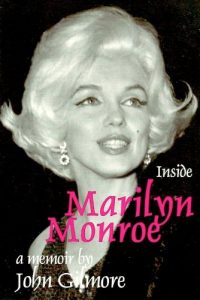 John’s book Inside Marilyn Monroe tells of his casual meetings with her. Unlike many other authors that have written about being in the same circles as Marilyn, John does not embellish or exaggerate his role in her life. His friend Jill Kaiser Adams said of him “He didn’t want to write it as he thought he had no story tell. He said “Listen Jill, I knew her as an actress, I wasn’t there when she died. I didn’t have a romantic relationship with her, so who will care?” I told him that he had an honest story to tell and we love honest stories about her. ” He first met her through a friend at her Doheny Drive apartment, saw her a few times on the Hollywood circuit, and had a memorable encounter walking through the park in the rain with her in New York City when they were both at The Actor’s Studio. There was an unsuccessful attempt for them to work together on the film The Stripper. John wrote of Marilyn: “I confess my timidity or selfishness for the half dozen or so times I was in Marilyn’s company and never reached past her fame to engage our spirits….I failed because I was intimidated by Marilyn’s success.” He roundly denounces those who have attempted to seek fame for themselves through brief or nonexistent relationships with her, and laments that she has continued to be a victim of commercialization and conspiracy.
John’s book Inside Marilyn Monroe tells of his casual meetings with her. Unlike many other authors that have written about being in the same circles as Marilyn, John does not embellish or exaggerate his role in her life. His friend Jill Kaiser Adams said of him “He didn’t want to write it as he thought he had no story tell. He said “Listen Jill, I knew her as an actress, I wasn’t there when she died. I didn’t have a romantic relationship with her, so who will care?” I told him that he had an honest story to tell and we love honest stories about her. ” He first met her through a friend at her Doheny Drive apartment, saw her a few times on the Hollywood circuit, and had a memorable encounter walking through the park in the rain with her in New York City when they were both at The Actor’s Studio. There was an unsuccessful attempt for them to work together on the film The Stripper. John wrote of Marilyn: “I confess my timidity or selfishness for the half dozen or so times I was in Marilyn’s company and never reached past her fame to engage our spirits….I failed because I was intimidated by Marilyn’s success.” He roundly denounces those who have attempted to seek fame for themselves through brief or nonexistent relationships with her, and laments that she has continued to be a victim of commercialization and conspiracy.
John was a member of the Marilyn Remembered fan club and often was a guest speaker at the club’s memorial services for her. He enjoyed telling stories about his heyday in the Hollywood scene from his perspective of the grit under the glamour. His good friend Holly Beavon says of him “John was one of the original leather jacket wearing, motorcycle riding bad boys of Hollywood. He would get that charming, sweet, mischievous giggle as he’d describe those days at Googies and being considered dangerous by the studio. ”
In an email to his friend Ian Ayres, John wrote “All I need is a table or booth with a wall at my back, a paper cup or two of coffee and about a three-hour flight of speaking the language of what I do, one sentence racing into the next and then the next, a nonstop express. Then another day is done and it is time for lunch.”
John is survived by his son Carson and his daughter Ursula.
His tribute to Marilyn written for Immortal Marilyn can be read here.
-Marijane Gray for Immortal Marilyn
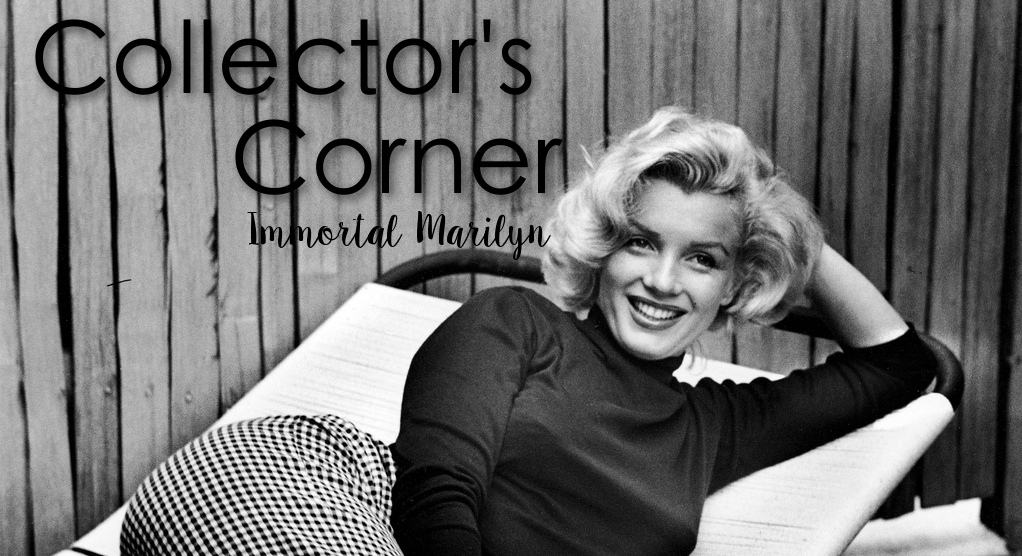
Welcome to another installment of Collector’s Corner! This month, meet IM contributor Sirkku Aaltonen
How long have you been collecting?
I started collecting when I was eleven, in 1995. I had known of Marilyn ever since I was three, as I was allowed to watch some of her movies. But up until then, I didn’t really know anything about her, until I talked about her with my mom, we watched a documentary together and she bought me Spoto’s MM biography. Coincidentally, we had to give a presentation at school, so I chose Marilyn as my subject. I ran out and bought some Marilyn postcards to use in my presentation. That was really the beginning of my collection.
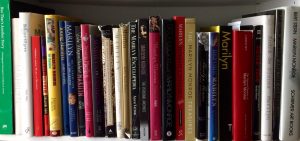 What is in your collection? Do you focus on one particular area or collect all kinds of Marilyn items?
What is in your collection? Do you focus on one particular area or collect all kinds of Marilyn items?
Marilyn is still relatively hard to come by in Finland, and even more so twenty years ago. I started by collecting anything with her name or face on it. Postcards were my main thing, and I have hundreds of them. Later on, I’ve focused on good books, documentaries, special items, vintage magazines etc. I sometimes receive Marilyn items as gifts, which really warms my heart
What is your most prized item?
It’s hard to say what the most prized item in my collection is, because so many things have memories and stories attached to them. The items may or may not be anything special or valuable, but they’re dear to me. I do have a vintage Finnish magazine with a photo of her on the cover that I, or other Marilyn experts, had not seen anywhere else before. I was going through piles of old magazines on sale, when peekaboo! It was clearly her, but it was so hard for me to believe it, because of the rare photo. It was as if she had a special surprise for me. And it happened on August 5th.
What item would you most like to add to your collection?
I’m always looking to add great books and other interesting items to my collection. My dream is to have something that belonged to her.
Is there any advice you’d like to offer a new collector?
These days it’s pretty easy to order anything Marilyn related on the internet. If you’re just starting out, beware that it might not be possible to collect literally everything with her on it. Pick and choose what it is that you really want. Is it books? Photos? Or in case you want a little bit of everything, what items do you simply like most? After all, a collection should be something you enjoy.
What do your friends and family think of your collection?
I’ve been lucky because my family and friends have always been incredibly supporting. My aunt always gives me a Marilyn calendar for Christmas. My mother travelled with me to London for the Marilyn exhibition. When we moved into our current apartment, I told my boyfriend I want some Marilyn here and there, but that he could choose what and where. As a result, you can tell someone here likes Marilyn, but she’s not overwhelming. Although there might be piles of books here and there that are also quite telling…


